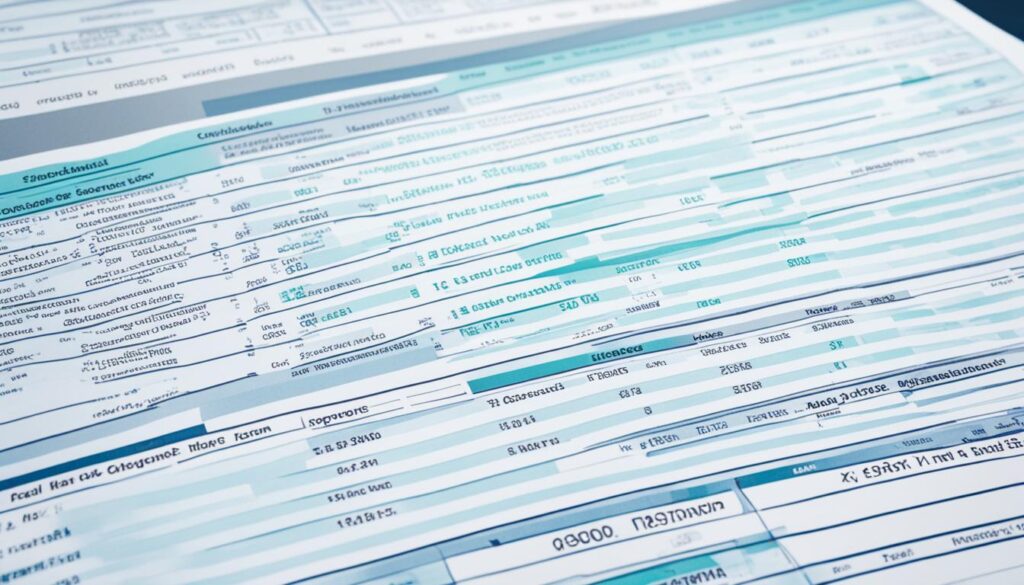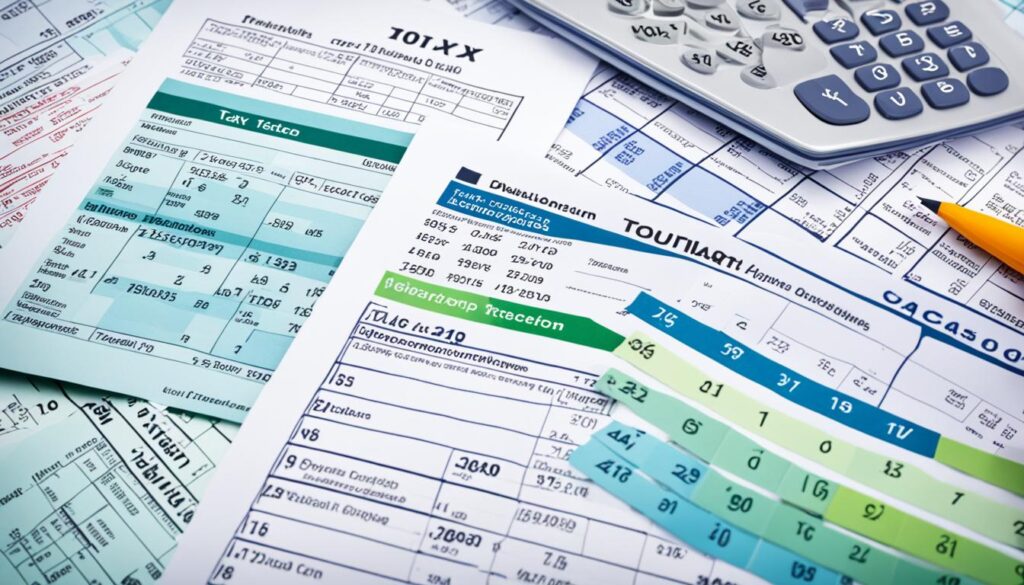Feeling lost with partnership taxes? Wondering how to handle income, deductions, and distributions? You’re in the right spot! In this guide, we’ll make partnership taxes easy to understand. We aim to help you master reporting partnership income. This guide is perfect whether you’re part of a small business partnership or thinking about starting one. You’ll learn how to follow the rules and enjoy tax advantages.
Partnerships operate differently from other businesses because they don’t pay federal income taxes directly. Instead, they pass their profits or losses to their partners. Then, the partners include this in their personal tax returns. But how exactly do you report your share of the income? And what about claiming deductions? This guide will clear up your questions and boost your confidence in managing partnership taxes.

Key Takeaways:
- Partnerships file an annual information return on Form 1065 to report income, deductions, gains, and losses.
- The partnership “passes through” profits or losses to its partners, who report their share on their personal tax returns.
- Distributions of profits or property must be properly documented and reported to ensure compliance with tax regulations.
- Partnerships have specific exclusion rules that determine which income and deductions are included or excluded from a partner’s personal tax return.
- Ending a partnership has tax implications, including filing a final tax return and potential tax consequences related to the liquidation of partnership assets.
How to Form a Partnership
To form a partnership, you must take several important steps. By following these, you make sure the process of forming a partnership goes smoothly. It also helps set a strong base for your business.
1. Agree on the Partnership Terms: It’s key to agree on the terms and conditions at the start. Discuss how much each partner will put in, how profits will be shared, and who gets to make decisions. Being open and honest is crucial to make sure everyone agrees.
2. Choose a Business Name: Picking a unique and catchy name for your business is vital. The name should show what your partnership is about and attract your ideal customers. Make sure to check if the name is not already taken to avoid legal issues.
3. Obtain Licenses and Permits: Your business might need certain licenses or permits, depending on what it does. Do your homework to find out what you need based on your industry and where you are located. This is to make sure you follow the rules.
4. Register with the Authorities: You have to register your partnership with state or local authorities. This means filling out forms and possibly paying fees. The steps you need to take can differ, so follow the rules for where your business is.
5. Draft a Partnership Agreement: Making a partnership agreement is a smart move. This document will outline each partner’s rights and duties. It covers how profits are shared, how decisions are made, and how to handle disagreements. Getting help from a lawyer who knows about partnerships can make your agreement solid and legally sound.
After completing these steps, your partnership is officially formed, and you can start your business. Forming your partnership correctly lays a solid foundation for success. It paves the way for a beneficial relationship in your business.
Partnership Distributions: How They Work
Partnership distributions split profits and property among partners. They offer flexibility in profit sharing, following the partnership agreement. These can be cash or property, based on what the partnership decides.
Profit sharing often reflects how much of the partnership each person owns. If you own more, you usually get more profit. Yet, the partnership agreement can change this setup.
It’s key to properly record and report these distributions for tax purposes. These records affect personal tax returns. The partnership agreement explains how to handle distributions.
Sometimes, partners can withdraw funds from their capital accounts. This is different from profit sharing. The partnership agreement will have specific rules for these withdrawals. These withdrawals can impact finances and taxes, so it’s important to be careful.
Understanding partnership distributions and withdrawals is crucial. They are key to how a partnership works financially. Proper documentation helps with tax compliance and ensuring profits are shared fairly.
Understanding Partnership Exclusion Rules
Partnership exclusion rules are key in figuring out what partners must pay taxes on. They help partners report income and deductions right. Knowing these rules helps follow tax laws.
Some partnership income, like tax-free interest, doesn’t get taxed. Partners don’t need to include this in their tax returns. This can lower their taxes. Understanding excluded income is vital for tax planning.
Likewise, certain deductions have limits or may not be allowed. While many business expenses are deductible, some have restrictions. For example, high partner salaries might not be fully deductible. It’s important for partners to know these rules to claim deductions correctly.
Partnerships need to detail their finances yearly on Form 1065. This shows the IRS the partnership’s financial activity. Partners get a Schedule K-1 showing their share of income, deductions, and credits. They use this to file their personal taxes.
Following these rules helps partners avoid tax issues. Knowing which incomes and deductions are allowed is crucial. For accurate tax reporting and benefits, consider consulting a tax expert familiar with partnership rules.
Key Points:
- Partnership exclusion rules determine the inclusion or exclusion of income and deductions on a partner’s personal tax return.
- Certain types of income, such as tax-exempt interest, may be excluded from taxable income.
- Partnership deductions may be subject to limitations or exclusions.
- Partnerships must accurately report income and deductions on Form 1065 and provide partners with Schedule K-1.
- Consulting a tax professional is recommended to navigate partnership exclusion rules and optimize tax benefits.
| Benefits | Considerations |
|---|---|
| Allows partners to exclude certain types of income from their personal tax returns, potentially reducing taxable income. | Partners must accurately identify and document excluded income to avoid compliance issues. |
| Restricts deductions that may be subject to exclusions or limitations, ensuring proper reporting and compliance. | Partnerships must navigate these rules diligently to optimize deductions. |
| Provides partners with a clear understanding of their share of income and deductions through Schedule K-1. | Partners must accurately report their shares on their personal tax returns to avoid penalties. |
Ending a Partnership: Tax Implications
Ending a partnership involves dealing with tax effects. Understanding these effects is key to follow rules and avoid surprises. In this part, we discuss the tax implications of ending a partnership.
The Final Tax Return
A final tax return is a must when ending a partnership. It’s filed on Form 1065, U.S. Return of Partnership Income. This return must include all income, deductions, and credits until ending.
Partners need to report their income or loss on their tax returns. They use a Schedule K-1 for this. It’s vital to ensure these reports are accurate.
Liquidation of Partnership Assets
Ending a partnership can impact taxes related to selling or sharing assets. The partnership must handle its debts and share leftover money with the partners. Both the partnership and the partners might face capital gains or losses.
A tax expert can guide through asset liquidation and tax reporting. It’s wise to get a tax professional’s help during this time.
“Ending a partnership’s tax effects can be complex. It’s essential to seek expert tax advice to follow the rules and secure the best financial outcome.”
Here’s an example of potential tax effects when ending a partnership:
| Partnership Assets | Value at Dissolution | Original Cost |
|---|---|---|
| Real Estate Property | $500,000 | $250,000 |
| Investment Portfolio | $300,000 | $200,000 |
| Business Equipment | $100,000 | $150,000 |
The table shows asset values and original costs at the partnership’s end. Assets may be sold or given to partners. Taxes must be paid on any gains or losses.
Getting tax advice is crucial for handling asset liquidation and meeting tax laws.

We’ll now look at how partners should report their income using Schedule K-1. Correct reporting is essential.
Reporting Partnership Income on Personal Tax Returns
Partners in businesses share resources and profits. But at tax time, they must report their income or losses. This is done on their own tax returns.
The main form used is Schedule K-1, Partner’s Share of Income, Deductions, Credits, etc. Each partner gets a Schedule K-1 from the partnership. It shows their share of income, deductions, and credits.
Partners should accurately report this info on their tax returns. This follows tax laws and avoids penalties. If not, the tax authorities might check more closely.
To add Schedule K-1 info to your tax return, look carefully at where it goes. Include all data like income, deductions, and credits.
If you’re unsure, get help from a tax pro who knows about partnerships. They ensure everything is reported right. They also help you find tax benefits or deductions.
Here are the steps to report partnership income on tax returns:
- Get your Schedule K-1 from the partnership.
- Check the Schedule K-1’s accuracy.
- Find where to report this on your tax return.
- Enter the financial data from Schedule K-1 on your return.
- Check your work and review your return before filing.
Reporting income from partnerships is key for tax compliance. By following these steps and getting help if needed, partners can report accurately. This ensures their tax returns show the right income and deductions.
Example Schedule K-1

Partnership Tax Forms and Filing Deadlines
Partnerships must fill out various forms to stay right with IRS rules. The main form they need is Form 1065, U.S. Return of Partnership Income. It shows the income, deductions, and other key financial details of the partnership. This form gives a full view of the partnership’s financial actions over the year.
Partnerships also need to give their partners Schedule K-1. This form shows each partner’s share of income and deductions. It’s important to fill out and give Schedule K-1 to partners before the deadline.
“Accurate and timely tax return filing is key to avoid penalties and follow tax laws.”
The deadline to file partnership tax returns is March 15th after the tax year ends. If needed, partnerships can ask for more time by using Form 7004. This gives them six more months, moving the due date to September 15th.
Even though partnerships usually don’t pay income tax, they must report their financial actions. Filing these forms shows openness and accountability.
For a better understanding of partnership tax forms and deadlines, see the table below:
| Tax Form | Purpose | Filing Deadline |
|---|---|---|
| Form 1065 | Reports partnership income, deductions, and credits | March 15th |
| Schedule K-1 | Reports partner’s share of income, deductions, and credits | Same as Form 1065 |
| Form 7004 | Requests an extension for filing Form 1065 | March 15th (original deadline) September 15th (with extension) |
It’s crucial for partnerships to take these deadlines seriously. They must gather all needed information and accurately complete the forms. Missing deadlines or submitting wrong information can lead to penalties.

We’ll look at employment taxes partnerships must handle next. This includes Social Security and Medicare taxes. It’s vital to understand and meet these duties to stay compliant with tax laws.
Employment Taxes for Partnerships
Partnerships must handle employment taxes for their partners, besides reporting income and deductions. It’s key for success, financial health, and following tax laws.
Social Security and Medicare Taxes
Partnerships need to manage Social Security and Medicare taxes for their partners. These are part of employment taxes, based on what each partner earns.
It’s important to use the right Social Security and Medicare tax rates for partners’ wages. Rates change yearly, so partnerships must keep up with IRS updates.
Partnership employment taxes support Social Security and Medicare. So, it’s vital that partnerships and partners meet these tax requirements.
Income Tax Withholding
Partnerships may also need to withhold income taxes from partner wages. The amount depends on each partner’s tax situation and must be calculated accurately.
Working closely with partners, partnerships can collect the needed information for federal income tax withholding. This step helps with personal and partnership tax compliance.
Form 941: Reporting and Payment
Partnerships file Form 941 for employment taxes each quarter. This form details the partnership’s tax responsibilities and is sent to the IRS on time.
On Form 941, partnerships list total wages, Social Security and Medicare taxes, and income tax withheld. Filing this form on time is important to avoid IRS penalties.
Note: Deadlines for Form 941 vary. Partnerships should check with the IRS or a tax advisor for exact dates.
Partner Statements: Schedule K-1
Every year, partnerships provide a Schedule K-1 to each partner. This shows each partner’s income, deductions, and credits from the partnership.
Although Schedule K-1 might not detail employment taxes paid, it helps partners report their tax responsibilities accurately on their returns.
Understanding and Compliance
Partnerships need to fully understand and take their tax duties seriously. Accurate records, proper withholdings, and timely actions are crucial.
Seeking advice from a tax professional is wise to ensure everything is done right. Professionals help navigate tax rules and fulfill obligations.
Note: This overview offers general advice. Tax laws for partnerships can vary. Always consult the IRS or a tax professional for specific guidance.

State Tax Requirements for Partnerships
Partnerships must file federal tax returns and might need to handle state taxes too. Each state has different tax rules for partnerships. It’s vital for partnerships to know and follow these rules to avoid fines and report taxes correctly.
In different states, the tax laws for partnerships can vary. If your partnership does business in more than one state, you need to know each state’s rules. Some states also ask for an annual report or fee, besides state tax returns.
Meeting state tax requirements means getting the right advice. Partnerships should talk to a state tax office or a tax professional who knows the state tax laws well. They can help you file your state tax returns on time and correctly.
It’s also important to keep up with changes in state tax laws. State tax rules can change, and partnerships need to stay updated. This helps them remain in compliance and avoid problems with the law or extra fines.
State Tax Obligations for Partnerships
- Filing state tax returns: Partnerships must file state tax returns in states where they do business. These returns share the partnership’s earnings, deductions, and credits in that state.
- Paying state taxes: Partnerships need to pay state taxes on their income in every state where they operate.
- State tax reporting requirements: Apart from filing tax returns, partnerships might have to file annual reports or pay fees in some states.
Following state tax rules is crucial for partnerships. By knowing what’s required and seeking expert advice, partnerships can handle state taxes well. This keeps them in good standing and helps avoid legal or financial issues.

International Tax Considerations for Partnerships
Partnerships with international deals or foreign partners have extra tax rules to follow. They must know and follow international tax laws to avoid fines. This ensures they report their taxes correctly.
Form 5471: If a U.S. person owns or controls a foreign corporation, they must file Form 5471. This form is for partnerships that need to share details about their foreign work or deals.
Form 8990: Form 8990 helps partnerships figure out limits on business interest expense deductions. It is crucial for those with international business to know how this affects their taxes.
Filing Form 5471 and Form 8990 right is key for global partnerships. This helps them stick to tax rules and dodge penalties. They should get advice from a tax pro who knows about international partnership taxes.
Partnership Tax Planning and Strategies
Partnerships can save a lot on taxes with good planning. By using tax-saving strategies, they can pay less in taxes. Working with a tax expert is key to creating a plan that fits.
Maximizing Deductions
Maximizing deductions is important in partnership tax planning. Partnerships can write off costs like salaries and rent. Tracking expenses helps ensure all deductions are used, lowering the tax bill.
Strategic Tax-Saving Opportunities
Partnerships should look for tax-saving chances. They can do things like structure deals to pay less tax. Knowing tax laws helps find these opportunities.
“Partnerships should plan taxes with a strategy in mind. Being proactive with tax-saving strategies helps stay ahead financially.”
Expert Guidance for Partnership Tax Planning
Partnership tax rules are complex. It’s smart to get advice from a tax expert. They can offer insights and make sure partnerships follow tax laws and save money.
| Tax Planning Strategies | Description |
|---|---|
| Income Shifting | Partnerships may consider shifting income between partners in situations where one partner is subject to lower tax rates. |
| Retirement Contribution Planning | Partnerships can explore retirement plans and contribute to tax-advantaged accounts like SEP IRAs or 401(k)s to reduce taxable income. |
| Timing of Expenses | Partnerships can strategically time their expenses to maximize deductions and offset taxable income. |
| Capital Asset Planning | Considering the tax implications of buying, selling, or disposing of capital assets can help partnerships minimize their tax liability. |

Partnerships have many ways to plan taxes and save money. With a tax expert’s help, they can use deductions and plan wisely. This helps them save on taxes and meet their goals.
Consulting a Tax Professional for Partnership Taxes
Tax rules for partnerships can be tough to understand. It’s vital to get help from a tax professional who knows the ropes. They can guide you on income, deductions, and how to distribute them properly.
Working with a tax expert opens up ways to save on taxes and improve your financial state. They find deductions and credits you might miss, cutting down what the partnership owes. Tax professionals also keep you up-to-date with tax laws and rules, helping you avoid fines.
Having a tax professional on your side eases the stress of partnership tax duties. It lets business owners concentrate on their main tasks. They make sure everything is reported right and deal with tax problems fast.
In sum, getting a tax professional to help with partnership taxes is key. With the help of a partnership tax advisor or expert, you can follow the rules, save on taxes, and do well financially.